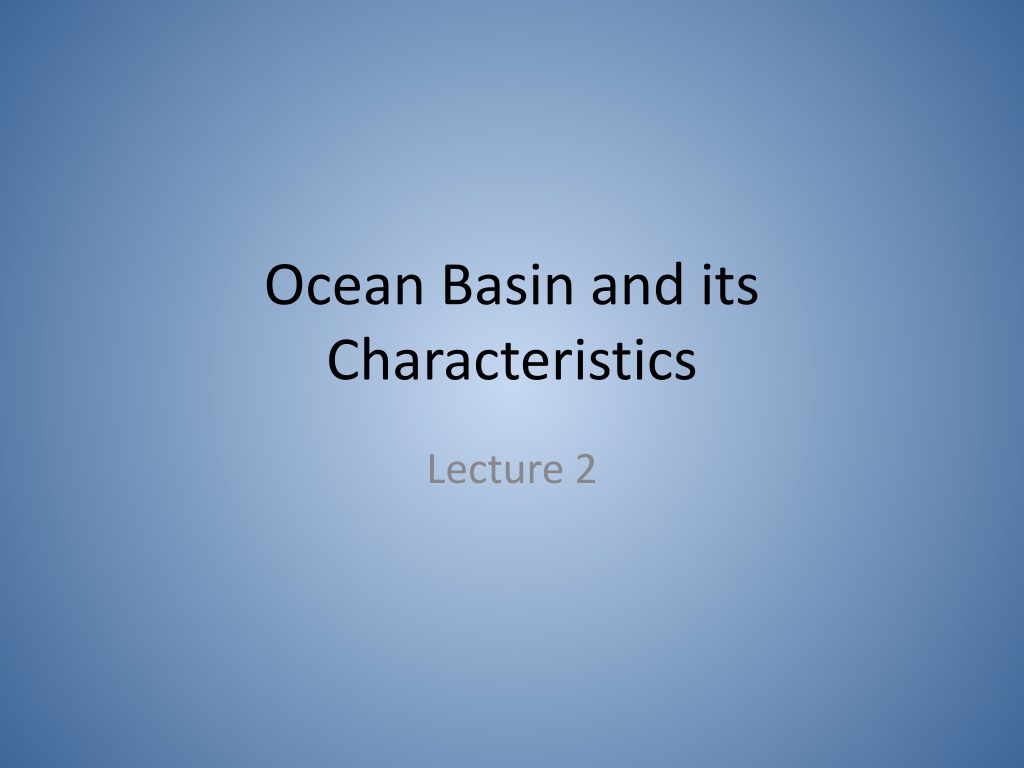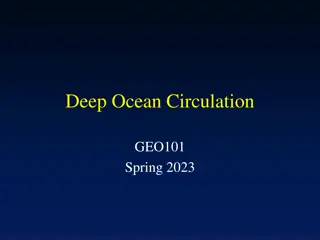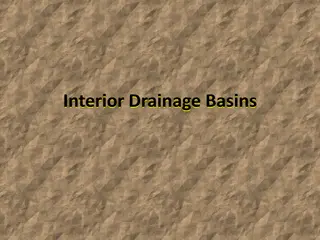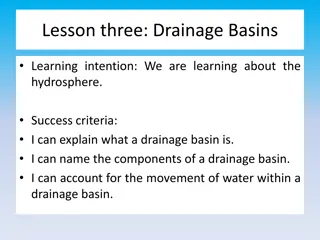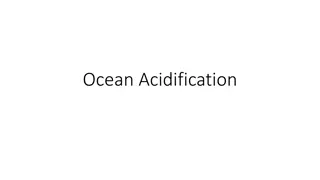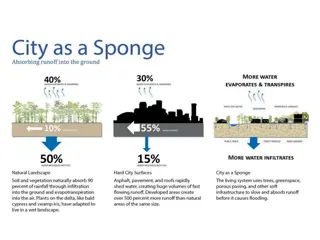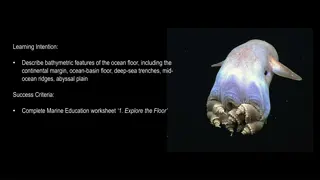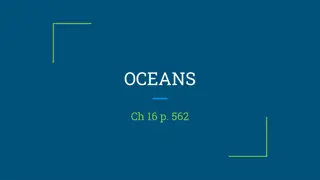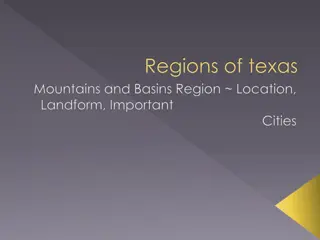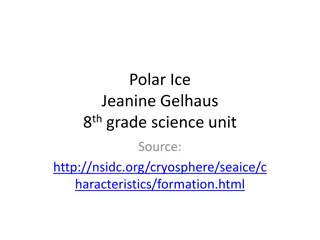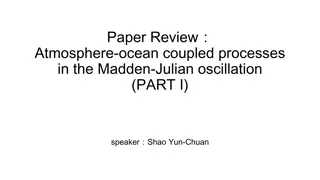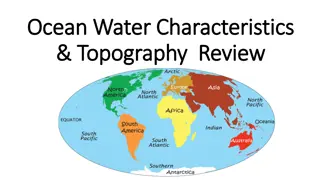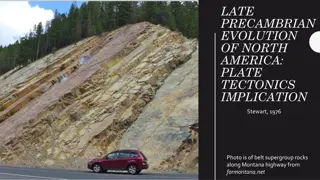Understanding Ocean Basins and Their Characteristics
Ocean basins are vast submarine regions that cover a significant portion of the Earth's surface, hosting the majority of the planet's water. These basins exhibit various features such as ocean ridges, deep-sea trenches, and seismic ridges. The ocean floor is constantly evolving due to plate tectonics, with new oceanic crust forming at spreading centers while old crust is destroyed at subduction zones. The unique characteristics of ocean basins are influenced by the thermal properties of oceanic plates and tensional forces.
Download Presentation

Please find below an Image/Link to download the presentation.
The content on the website is provided AS IS for your information and personal use only. It may not be sold, licensed, or shared on other websites without obtaining consent from the author. Download presentation by click this link. If you encounter any issues during the download, it is possible that the publisher has removed the file from their server.
E N D
Presentation Transcript
Ocean Basin and its Characteristics Lecture 2
Ocean Basin Ocean basin, any of several vast submarine regions that collectively cover nearly three-quarters of Earth s surface. Together they contain the overwhelming majority of all water on the planet and have an average depth of almost 4 km (about 2.5 miles). The basins also contain a variable amount of sedimentary fill that is thinnest on the ocean ridges and usually thickest near the continental margins.
Cont. A number of major features of the basins depart from this average for example, the mountainous ocean ridges, deep-sea trenches, linear fracture zones. Other significant features of the ocean floor include a seismic ridges, abyssal hills, and seamounts and guyots.
Cont. While the ocean basins lie much lower than sea level, the continents stand high about 1 km (0.6 mile) above sea level. The physical explanation for this condition is that the continental crust is light and thick while the oceanic crust is dense and thin. Both the continental and oceanic crusts lie over a more uniform layer called the mantle.
cont The ocean basins are transient features over geologic time, changing shape and depth while the process of plate tectonics occurs. Continental slop is 15 km average width. The surface layer of Earth, the lithosphere, consists of a number of rigid plates that are in continual motion. The boundaries between the lithospheric plates form the principal relief features of the ocean basins: the crests of oceanic ridges are spreading centres where two plates move apart from each other at a rate of several centimeters per year.
Molten rock material wells up from the underlying mantle into the gap between the diverging plates and solidifies into oceanic crust, thereby creating new ocean floor. At the deep-sea trenches, two plates converge, with one plate sliding down under the other into the mantle where it is melted. Thus, for each segment of new ocean floor created at the ridges, an equal amount of old oceanic crust is destroyed at the trenches, or so-called subduction zones. It is for this reason that the oldest segment of ocean floor, found in the far western Pacific, is apparently only about 200 million years old, even though the age of Earth is estimated to be at least 4.6 billion years.
Governing Factors The dominant factors that govern seafloor relief and topography are the thermal properties of the oceanic plates, tensional forces in the plates, volcanic activity, and sedimentation. In brief, the oceanic ridges rise about 2 km (1.2 miles) above the seafloor because the plates near these spreading centres are warm and thermally expanded. In contrast, plates in the subduction zones are generally cooler.
Cont. Tensional forces resulting in plate divergence at the spreading centres also create block-faulted mountains and abyssal hills, which trend parallel to the oceanic ridges. Seamounts and guyots, as well as abyssal hills and most aseismic ridges, are produced by volcanism. Continuing sedimentation throughout the ocean basin serves to blanket and bury many of the faulted mountains and abyssal hills with time. Erosion plays a relatively minor role in shaping the face of the deep seafloor, in contrast to the continents. This is because deep ocean currents are generally slow (they flow at less than 50 cm [20 inches] per second) and lack sufficient power.
Oceanic ridge Oceanic ridge, continuous submarine mountain chain extending approximately 80,000 km (50,000 miles) through all the world s oceans. Individually, ocean ridges are the largest features in ocean basins. Collectively, the oceanic ridge system is the most prominent feature on Earth s surface after the continents and the ocean basins themselves. In the past these features were referred to as mid-ocean ridges, but, as will be seen, the largest oceanic ridge, the East Pacific Rise, is far from a mid-ocean location, and the nomenclature is thus inaccurate. Oceanic ridges are not to be confused with aseismic ridges, which have an entirely different origin.
Principal Characteristics Oceanic ridges are found in every ocean basin and appear to girdle Earth. The ridges rise from depths near 5 km (3 miles) to an essentially uniform depth of about 2.6 km (1.6 miles) and are roughly symmetrical in cross section. They can be thousands of kilometres wide. In places, the crests of the ridges are offset across transform faults within fracture zones, and these faults can be followed down the flanks of the ridges. (Transform faults are those along which lateral movement occurs.) The flanks are marked by sets of mountains and hills that are elongate and parallel to the ridge trend.
Oceanic ridges offset by transform faults and fracture zones. The arrows show the direction of movement across the transform faults.
Seafloor Spreading New oceanic crust (and part of Earth s upper mantle, which, together with the crust, makes up the lithosphere) is formed at seafloor spreading centres at these crests of the oceanic ridges. Because of this, certain unique geologic features are found there. Fresh basaltic lavas are exposed on the seafloor at the ridge crests. These lavas are progressively buried by sediments as the seafloor spreads away from the site.
Seafloor Spreading The flow of heat out of the crust is many times greater at the crests than elsewhere in the world. Earthquakes mare common along the crests and in the transform faults that join the offset ridge segments. Analysis of earthquakes occurring at the ridge crests indicates that the oceanic crust is under tension there. A high-amplitude magnetic anomaly is center over the crests because fresh lavas at the crests are being magnetized in the direction of the present geomagnetic field.
Three-dimensional diagram showing crustal generation and destruction according to the theory of plate tectonics; included are the three kinds of plate boundaries divergent, convergent (or collision), and strike-slip (or transform).
Besides ridge width, other features appear to be a function of spreading rate. Global spreading rates range from 10 mm (0.4 inch) per year or less up to 160 mm (6.3 inches) per year. Oceanic ridges can be classified as slow (up to 50 mm [about 2 inches] per year, intermediate (up to 90 mm (about 3.5 inches) per year, and fast (up to 160 mm per year).
Slow-spreading ridges are characterized by a rift valley at the crest. Such a valley is fault- controlled. It is typically 1.4 km (0.9 mile) deep and 20 40 km (about 12 25 miles) wide. Faster- spreading ridges lack rift valleys. At intermediate rates, the crest regions are broad highs with occasional fault-bounded valleys no deeper than 200 metres (about 660 feet). At fast rates, an axial high is present at the crest. The slow-spreading rifted ridges have rough faulted topography on their flanks, while the faster-spreading ridges have much smoother flanks.
